
The Local Group is the galaxy group that includes the Milky Way. It has a total diameter of roughly 3 megaparsecs (10 million light-years; 9×1022 metres), and a total mass of the order of 2×1012 solar masses (4×1042 kg). It consists of two collections of galaxies in a "dumbbell" shape: the Milky Way and its satellites form one lobe, and the Andromeda Galaxy and its satellites constitute the other. The two collections are separated by about 800 kpc (3×10^6 ly; 2×1022 m) and are moving toward one another with a velocity of 123 km/s. The group itself is a part of the larger Virgo Supercluster, which may be a part of the Laniakea Supercluster. The exact number of galaxies in the Local Group is unknown as some are occluded by the Milky Way; however, at least 80 members are known, most of which are dwarf galaxies.
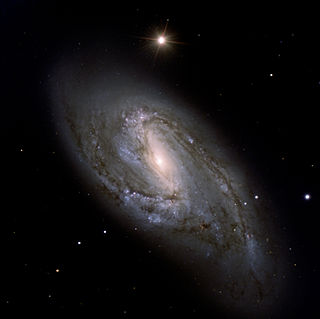
Messier 66 or M66, also known as NGC 3627, is an intermediate spiral galaxy in the southern, equatorial half of Leo. It was discovered by French astronomer Charles Messier on 1 March 1780, who described it as "very long and very faint". This galaxy is a member of a small group of galaxies that includes M65 and NGC 3628, known as the Leo Triplet, or the M66 Group. M65 and M66 make a popular pair for observers, being separated by only 20′.
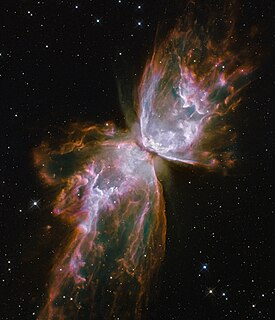
NGC 6302 is a bipolar planetary nebula in the constellation Scorpius. The structure in the nebula is among the most complex ever observed in planetary nebulae. The spectrum of NGC 6302 shows that its central star is one of the hottest stars known, with a surface temperature in excess of 250,000 degrees Celsius, implying that the star from which it formed must have been very large.
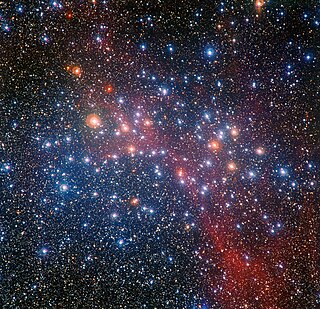
NGC 3532, also commonly known as the Pincushion Cluster, Football Cluster, the Black Arrow Cluster and the Wishing Well Cluster, is an open cluster some 405 parsecs from Earth in the constellation Carina. Its population of approximately 150 stars of 7th magnitude or fainter includes seven red giants and seven white dwarfs. On 20 May 1990 it became the first target ever observed by the Hubble Space Telescope. A line from Beta Crucis through Delta Crucis passes somewhat to the north of NGC 3532. The cluster lies between the constellation Crux and the larger but fainter "False Cross" asterism. The 4th-magnitude Cepheid variable star x Carinae appears near the southeast fringes, but it lies between the Sun and the cluster and is not a member of the cluster.

NGC 189 is an open cluster in the Cassiopeia constellation. It was discovered by Caroline Herschel on 27 September 1783, and independently rediscovered by John Herschel on 27 October 1829.
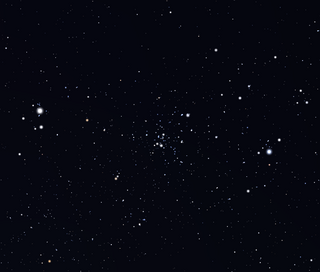
NGC 559 is an open cluster and Caldwell object in the constellation Cassiopeia. It shines at magnitude +9.5. Its celestial coordinates are RA 01h 29.5m, dec +63° 18′. It is located near the open cluster NGC 637, and the bright magnitude +2.2 irregular variable star Gamma Cassiopeiae. The cluster is 7 arcmins across.
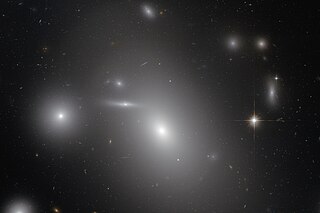
NGC 4889 is an E4 supergiant elliptical galaxy. It was discovered in 1785 by the British astronomer Frederick William Herschel I, who catalogued it as a bright, nebulous patch. The brightest galaxy within the northern Coma Cluster, it is located at a median distance of 94 million parsecs from Earth. At the core of the galaxy is a supermassive black hole that heats the intracluster medium through the action of friction from infalling gases and dust. The gamma ray bursts from the galaxy extend out to several million light years of the cluster.
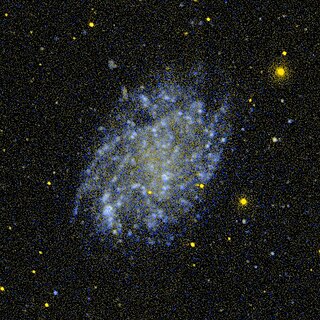
NGC 45 is a low surface brightness spiral galaxy in the constellation of Cetus. It was discovered on 11 November 1835 by the English astronomer John Herschel.

NGC 2775 is a spiral galaxy in the northern constellation of Cancer, located at a distance of 67 megalight-years from the Milky Way. It was discovered by William Herschel in 1783. NGC 2775 belongs to the Antlia-Hydra Cluster of galaxies and is the most prominent member of a small galaxy group known as NGC 2775 group, part of the Virgo Supercluster, along with the Local Group. Other members of the NGC 2775 group include NGC 2777 and UGC 4781.

NGC 4697 is an elliptical galaxy some 40 to 50 million light-years away in the constellation Virgo. It is a member of the NGC 4697 Group, a group of galaxies also containing NGC 4731 and several generally much smaller galaxies This group is about 55 million light-years away; it is one of the many Virgo II Groups, which form a southern extension of the Virgo Supercluster of galaxies.

NGC 4550 is a barred lenticular galaxy located in the constellation of Virgo that can be seen with amateur telescopes. It lies at a distance of 50 million light-years from the Milky Way and is a member of the Virgo Cluster.

UGC 480 is a spiral galaxy located approximately 500 million light-years from the Sun in the constellation Andromeda. It was discovered on October 17, 1876 by Édouard Stephan, and is interacting with the galaxy PGC 2726.

NGC 266 is a massive barred spiral galaxy in the constellation Pisces. NGC 266 is located at a distance of 197 megalight-years from the Milky Way. It was discovered on September 12, 1784, by William Herschel. The form of this barred galaxy is described by its morphological classification of SB(rs)ab, which indicates a quasi-ring-like structure (rs) and moderate-to-tightly wound spiral arms (ab). It is the dominant member of a small group with six low-mass galaxies.

NGC 330 is an open cluster in the Small Magellanic Cloud. It is located in the constellation Tucana. It was discovered on 1 August, 1826 by James Dunlop. It was described by Dreyer as "a globular cluster, very bright, small, a little extended, stars from 13th to 15th magnitude." At an aperture of 31.0 arcseconds, the apparent V-band magnitude is 9.60, but at this wavelength, it also has 0.36 magnitudes of interstellar extinction.

NGC 7047 is an intermediate spiral galaxy located about 270 million light-years away in the constellation of Aquarius. NGC 7047 is also classified as a LINER-type galaxy. NGC 7047 has an estimated diameter of 127,350 light years. It was discovered by French astronomer Édouard Stephan on August 20, 1873. In 2009 a supernova was found in NGC 7047.

NGC 484 is an elliptical galaxy in the constellation Tucana. It is located approximately 218 million light-years from Earth and was discovered in on October 28, 1834 by astronomer John Herschel.

NGC 592 is a H II region type emission nebula located in the Triangulum galaxy (M33) and thus in the constellation of Triangulum. The nebula contains an open cluster of stars and is approximately 2.86 million light-years away from Earth.

NGC 703 is a lenticular galaxy located 240 million light-years away in the constellation Andromeda. The galaxy was discovered by astronomer William Herschel on September 21, 1786 and is also a member of Abell 262.

NGC 709 is a lenticular galaxy located 150 million light-years away in the constellation Andromeda. It was discovered by the Irish engineer and astronomer Bindon Blood Stoney on October 28, 1850 and is a member of the galaxy cluster Abell 262.

NGC 710 is a spiral galaxy located 260 million light-years away in the constellation Andromeda. It was discovered by the Irish engineer and astronomer Bindon Blood Stoney on October 28, 1850 and is a member of the galaxy cluster Abell 262.





















